
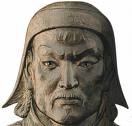
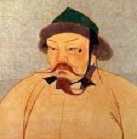
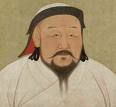


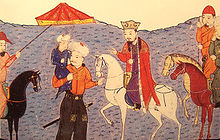





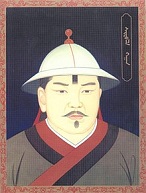

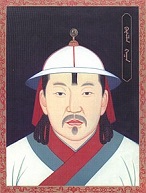
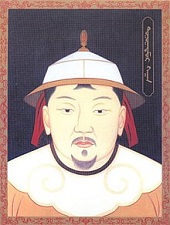




















TLW's Mongolscope™ (Mongol Historyscope) |
By T.L. Winslow (TLW), the Historyscoper™ |
© Copyright by T.L. Winslow. All Rights Reserved. |
Original Pub. Date: Apr. 15, 2019. Last Update: Oct. 28, 2025. |
Westerners are not only known as history ignoramuses, but double dumbass history ignoramuses when it comes to the Mongols, Mongol history, and the Mongol Empire (1206-1368). Since I'm the one-and-only Historyscoper (tm), let me quickly bring you up to speed before you dive into my Master Historyscope.
The Mongols are history's original Hell's Angels, riding their hogs roughshod over the known world and conquering whatever they wanted. Today they are but a distant memory, but in their heyday they conquered more territory than the Romans in far less time, welcome to my world.
About 43K B.C.E. stone tools are made in Mongolia.
About 3K B.C.E. the earliest known milk protein is found on human teeth in Mongolia.
In 905 C.E. the Khitan (Qitan) Empire of Mongolians from S Manchuria is founded in NE China, going on to rule Mongolia, NE China, and portions of the Russian Far East and North Korea in 916-1125.
In 916 C.E. Yelu Abaoji (872-926) declares himself emperor of the Mongolian Khitans in NE China, founding the Liao Dynasty (ends 1125).



In 1206 Temujin ("iron-worker") is acknowledged as the supreme leader of the steppes at a kuriltai (tribal meeting), and given the name Genghis (Chingis) (Jengis) Khan (1162-1227), "emperor of all emperors" (chief prince of the Mongols), uniting the Mongols and molding them into a fighting force before invading Manchuria; the Yassa (Yasa) is secretly created to force fierce military discipline through the empire - I don't care, it's 5 o'clock somewhere, let's get going? Why Genghis Khan Refused To Invade India | Abhijit Chavda
In 1211 Mongol attacks on the Manchurian Jin Dynasty begin, led by Genghis Khan, who gets the edge when the stupid Jin cmdr. sends messenger Ming-Tan to talk rather than attack first, and he defects and gives away their position at Badger Pass, allowing the Mongols to massacre thousands of Jin troops and win a big V.

On Jan. 18, 1213 Georgian queen (since Mar. 27, 1184) Tamar the Great (b. 1160) dies, having expanded her pan-Caucasian realm from the Greater Caucasus Crest in the N to Erzurum in the S, and from Zygii in the NW to Ganja in the SE, with Shirvan as a vassal, Trebizond as an ally, and the Zachariad regime in Armenia as an ally; her son (coregent since 1207) George (Giorgi) IV Lasha (1191-1223) succeeds as king of Georgia (until Jan. 18, 1213), going on to face the horrific Mongols and see the empire crumble while going for Sufism.
On Apr. 22, 1216 the Battle of Lipitsa sees Konstantin Vsevolodovich allied with Mstislav the Bold defeat Yuri II and take the throne of Vladimir (until 1218); meanwhile the infighting in Russia softens it up for the coming Mongol invasion?
In 1218 Genghis Khan and his hordes conquer the neighboring Xi (Western) Xia, Jin, and Qara-Khitai (founded in 1124) empires (ruled by Naiman), capturing Semirechye and the Tarim Basin, and occupying Kashgar, followed by Persia; Alaeddin Mohammed signs a treaty with him.
In 1219 after a Mongol chief allies with Khwarezm shah Ala al-Din Muhammad (Alaeddin Mohammed) II (1169-1220), causing Genghis Khan to return and supress the rebellion and send an officer of peace, two Mongol merchants are executed as spies by the gov. of Otrar in Transoxiana, causing Genghis Khan to demand his extradition, which Muhammad refuses, beheading the chief of the Mongol embassy and sending the rest back sans beards, pissing-off Genghis Khan, who begins the Mongol invasion of the Muslim World, starting with leading 200K troops W to invade Afghanistan, destroying its irrigation systems and turning fertile land into permanent desert.
In 1220 leading a punitive expedition against the Khwarezm Empire in E Persia (ends 1223), the Mongol hordes of Genghis Khan (1162-1227) invade Transoxiana and Khorasan; under Genghis' son Juji they defeat 400K Khwarezm troops in the Battle of Jand, killing 160K, and causing Kwarezmshah Ala al-Din Muhammad (Alaeddin Mohammed) II to flee to Samarkand; the main army under Genghis Khan destroys Bukhara, raping thousands of women and massacring 30K men; Samarkand and Balkh surrender, only to suffer massacre and ruin, causing the shah to flee to a small Caspian Sea island, where he dies, and is succeeded by Jalal al-Din Manguberdi (-1231), the last Khwarem shah; 70K Mongols under Genghis' son Tule ravage Khorasan, making captives fight against their fellow soldiers or die; they capture and destroy Merv, known for its magnificent libraries, allowing the pop. to march through the gates with their treasures, killing all 1.3M (1.748M) in 1 hour?
In 1221 after a long siege, the Mongols under Genghis Khan capture Nishapur, killing all except 400 artisans, who are sent to Mongolia, with the heads piled in a giant pyramid; he then captures and destroys Rayy, known for its 3K mosques and pottery kilns, massacring the entire pop.; after gathering a new army of Turks, Kwarezm shah Jalal ad-Din is defeated in the Battle of the Indus River in modern-day Pakistan, and flees to Delhi, after which Genghis punishes Herat for rebelling against their Mongol governor, massacring 60K, ending the Khwarezm-Shah Dynasty (founded 1156); Genghis sends his gens. Chepe and Subotai on a recon mission with 20K horsemen through the whole of Persia, the Caucasus, the Carpathians, and into Russia, where by 1223 they virtually obliterate a Russian army of 80K; Genghis Khan spares N Persia, putting it under Mongol viceroys; after each battle each Mongol soldier is assigned to kill 50 captives with a battle axe and collect the right ears in sacks for counting; "They had trampled on the nations which opposed their passage, penetrated through the gates of Derbent, traversed the Volga and the desert, and accomplished the circuit of the Caspian Sea, by an expedition which had never been attempted, and has never been repeated" - Edward Gibbon, Ch. 64; apocalyptic rumors of Mongolian hordes travel as far as Britain and France.
In 1221 Uzbekistani Sufi leader Shaykh Najm al-Din Kubra (b. 1145) is martyred in Khorezm during the Mongol invasion; the Kubrawiyya Sufi order is later named after him by Ahmad Simnani (1261-1336); his mausoleum is located near Kunya Urgench.

On Jan. 18, 1223 Georgian king (since 1213) (son of Tamar) George IV Lasha (b. 1191) dies after repulsing Mongol attacks in 1221-2, and his sister Rusudan (1194-1245) becomes queen of Georgia (until 1245), facing more attacks by Mongols.
In Apr. 1223 Genghis Khan sends 10 ambassadors to Russian grand prince of Kiev (since 1212) Mystislav III Romanovich the Old (b. ?), who has them summarily executed, pissing-off the Mongols, who under Subitai invade S Russia from the Transcaucasus region, and defeat a coalition of Russians and Cumans at the Battle of the Kalka River in modern-day Donetsk Oblast, Ukraine near the Sea of Azov, capturing Mystislav III; "At the end of the campaign, Subodei and Jebe led their soldiers down to spend a relaxing spring in the Crimea on the Black Sea. They celebrated their victory with a great drunken party that lasted for days. The guest of honor was the defeated Prince Mstislav and his two sons-in-law, but their treatment showed how much the Mongols had changed since the time of Genghis Khan. The Mongols wrapped the three of them in felt rugs, as befitted high-ranking aristocrats, and stuffed them beneath the floorboards of their ger, thereby slowly, but bloodlessly, crushing the men as the Mongols drank and sang through the night on the floor above them. It was important to the Mongols that the Russians understand the severe penalty for killing ambassadors, and it was equally as important for the Mongol leaders to reaffirm to their own men the extent to which they would always be willing to go to avenge the unjust killing of a Mongol."
Lucky Ivan? In 1224 Mongol hordes invade Poland, Hungary, and Russia as far as Novgorod, but upon hearing that the Tanguts have rebelled, Genghis Khan returns E to Karakorum to deal with them.
In fall 1225 Georgia is attacked by the Khwarezmians under shah Jelal ad-Din Mingburnu, who is being pursued by the Mongols, who defeat the Georgians in the Battle of Garni and siege Tbilisi (until 1226), causing Queen Rusudan to move the capital to Kutaisi.

In 1226 Hetum (Hethum) (Hethoum) (Hetoum) (Het'um) (Hayton) I the Great (1213-70) becomes ruler of Christian Lesser Armenia (Cilicia) (until 1270), founding the Hetoumid Dynasty (ends 1342), going on to fight the pesky Mongols and Muslims.
On Aug. 18, 1227 after conquering the Western Xia (Xia Xia) (Hsi-Hsia) (Tangut) state in C China (founded in 1038), Genghis Khan (b. 1162) dies near Khentii Aimag in Yinchuan, Western Xia after conquering 4.86M sq. mi. from the Pacific Ocean to the Caspian Sea (incl. N China, Mongolia, S Siberia, and C Asia), and is succeeded by his 3rd son Ogedei (Ogodei) (Ogadai) (Ogotai) (Ughetai) (1186-1241). Gorgeous Genghis dies in bed after enjoying 500 wives and concubines; his burial party kills anybody seeing the procession, and all slaves and solders attending it are killed; a river is diverted over his grave, which isn't found until ?; his palace is uncovered in 2004.
In 1228 the Genghis-less Mongols defeat the Russians, but fail to consolidate their gains.

On Sept. 13, 1229 Ogedei (Ogotai) Khan (1186-1241), 3rd and favorite son of Genghis Khan becomes khan #2 of the Mongol Empire (until Dec. 11, 1241); the Mongols put an end to the sovereignty of the Uyghurs.
In 1231 the Mongols invade Korea for the first time (1231, 1232, 1235-9, 1251, 1254, 1255, 1257-9).
In 1232 the Mongol Siege of Kaifeng (Kai-fung-fu) (1232-3) sees the Chinese use rockets in warfare for the first time to defend Kaifeng against pesky Mongols; the use of gunpowder begins to spread.
In 1233 Song emperor (since Sept. 17, 1224) Song Li Zong (1205-64) and the Mongols attack the Manchurians and their Jin Dynasty.
In 1234 the Mongols conquer the Jin Dynasty in Manchuria in NE China (founded 1115).
In 1235 Batu Khan (-1255), nephew of the Great Khan becomes leader of the 500K-man Mongol army (one-third of the total royal or golden horde) assigned to invade Europe; his chief gen. is Subotai (Subetei) (Subetai) (Subedei) (1176-1240).
In 1235 after tiring of the nomadic life and calling in workers from Persia to China, Mongol khan (1229-41) Ogedei Khan establishes his capital at Karakorum ("black sand") in the Orkhon Valley of C Mongolia (until 1263), building a walled palace and turning it into a busy center of trade by encouraging merchants of all nations to pass through or settle there.
Bad to the bone? In 1236 the Mongols return to Russia and subjugate it over the next four years, sending spies deeper into Europe; Prince Yaroslav of Novgorod takes the advice of Danylo of Halych and moves to Kiev, after which his 4th son (St.) Alexander Nevsky (Nevski) (1220-63) is unexpectedly invited by the people of Novgorod to become their grand prince to defend them from pesky German and Swedish invaders.
In 1237 the Mongols under Batu Khan sweep over S and C Russia, take Ryazan and Vladimir, then come within 60 mi. of Novgorod, and capture and sack Moscow; grand prince Yuri II of Vladimir barely escapes to Yaroslavl after his wife Agatha and family die in a collapsing church.
On Mar. 4, 1238 Yuri II (b. 1189) is KIA in the Battle of the Sit River with the Mongol hordes, who defeat the army of Vladimir-Suzdal; Yuri II's younger brother Yaroslav becomes grand prince Yaroslav II Vsevolodovich (1191-1246) of what's left of Vladimir (until 1246), giving up his throne in what's left of Kiev, and going on to try to restore his ravaged cities.
In spring 1238 the Mongols under Batu Khan conquer Poland, destroying Lublin and Cracow; they then turn to Hungary, and "the whole country north of the Danube was lost in a day and depopulated in a summer... Of all the cities and fortresses of Hungary three alone survived the Tartar invasion, and the unfortunate Bela [IV] hid his head among the islands of the Adriatic" - Edward Gibbon, Ch. 64; in the winter after the Danube River freezes they siege the Hungarian capital of Esztergom (Strigonium) and massacre the pop.; meanwhile all of Europe trembles with rumors that the Mongol horde is coming; Pope Gregory IX sends a mission of Franciscan and Dominican friars, which is rebuffed; the town of Neustadt in Austria is defended by only 50 knights with 20 crossbows until a German army arrives.
In 1239 the Tartars (Mongols) lay waste to Serbia, Bosnia, and Bulgaria, then retreat to Russia so that Batu Khan can seriously enjoy the city and palace of Seria; meanwhile Batu's brother Sheibani conquers Siberia with 15K Mongol families, with capital at Tobolsk for the next three cents.

They may all be swarthy, but some swing north and some swing south? On Dec. 6, 1240 after a 2-week siege the Mongols under Golden Horde leader and founder (1227) Batu Khan (1205-55) (grandson of Genghis Khan) capture and raze Kiev, "mother of Russian cities", and slaughter its pop., permitting Muscovite Russia to emerge as dominant while clearing the Mongol path W to Europe; the Kievan Era of Russian history ends - and Russian babies start developing those Mongolian features?
In Feb. 1241 the Mongols cross the frozen rivers into C Europe then split into two armies, N and S; the 8K-20K-man N one under Kaidu and Baidar invades Poland and sacks Cracow on Mar. 18, then on Apr. 9 defeats a 2K-25K-man German, Polish, and Bohemian army led by Henry the Bearded's son Henry II the Pious (1196-1241), the Polish palatines, and the grandmaster of the Teutonic Order at the Battle of Liegnitz (Legnica) (Wahlstatt) in Legnickie Pole Silesia (SW Poland), after which they fill nine sacks with the right ears of the slain; Henry the Pious is KIA along with most of his knights after the faster Mongol ponies outmaneuver them; the Mongols capture Polish gold miners at the battle and take them back to the Caspian Sea and Siberia; meanwhile the S Mongol army under Batu and Subutai advances through Transylvania, and meets a united European army under Bela IV of Hungary on Apr. 11 at the Battle of the Sajo (Sajó) River (Tisza River) (Mohi) (Muhi) on the Sajo River NE of modern-day Muhi, Hungary, becoming the main battle between the Mongols and the Kingdom of Hungary, with 15K-70K Mongol cavalry defeating 25K-80K Hungarian light cavalry and Knights Templar crossbowmen, with ? Mongols and 10K Hungarians KIA; at first Bela IV drives the Mongols out onto the Plains of Muhi (Mohi) on the Theiss River SW of the Sajo River, but the Mongols win a decisive V, driving Bela to the Adriatic, and occupying the Great Hungarian Plain in modern-day S Transylvania and the Banat and its fabled alfoeld (perfect grazing grounds) for a year, and destroying 15%-35% of its pop.; in Apr. the N and S armies hook up. and finish pacifying all resistance, and the road to France is now open; the Mongols begin pursuing Bela IV - who starts sweating paprika?
On May 19, 1241-1265 Armenian historian Kirakos Gandzaketsi (1200-71) writes The Journey of King Hetoum of Little Armenia to Mongolia and Back, a history of Armenia from the 4th to 12th cent. C.E., becoming a primary source for the Mongol invasions and the first recorded word list of the Mongolian language; becomes a hit and is trans. into many languages - so what about you, Goldilocks, what do you fantasize about?
On June 24. 1241 Bulgarian tsar (since 1218) John Asen II is KIA during the invasion of Batu Khan, and his 7-y.-o. son Kaliman Asen I (1234-46) becomes tsar of Bulgaria (until Sept. 1246) just as the Mongols returning from C Europe decide to use his kingdom as ass-wipe?
In Feb. 1242 the Mongols cross the frozen rivers into C Europe then split into two armies, N and S; the 8K-20K-man N one under Kaidu and Baidar invades Poland and sacks Cracow on Mar. 18, then on Apr. 9 defeats a 2K-25K-man German, Polish, and Bohemian army led by Henry the Bearded's son Henry II the Pious (1196-1241), the Polish palatines, and the grandmaster of the Teutonic Order at the Battle of Liegnitz (Legnica) (Wahlstatt) in Legnickie Pole Silesia (SW Poland), after which they fill nine sacks with the right ears of the slain; Henry the Pious is KIA along with most of his knights after the faster Mongol ponies outmaneuver them; the Mongols capture Polish gold miners at the battle and take them back to the Caspian Sea and Siberia; meanwhile the S Mongol army under Batu and Subutai advances through Transylvania, and meets a united European army under Bela IV of Hungary on Apr. 11 at the Battle of the Sajo (Sajó) River (Tisza River) (Mohi) (Muhi); at first Bela IV drives the Mongols out onto the Plains of Muhi (Mohi) on the Theiss River SW of the Sajo River, but the Mongols win a decisive V, driving Bela to the Adriatic, and occupying the Great Hungarian Plain and its fabled alfoeld (perfect grazing grounds) for a year, and destroying 15%-35% of its pop.; in Apr. the N and S armies hook up. and finish pacifying all resistance, and the road to France is now open; the Mongols begin pursuing Bela IV - who starts sweating paprika?
In 1244 the Seljuk sultanate of Rum (Roum) (founded 1075) becomes a Mongol protectorate (vassal state) after reaching its zenith in the period from 1200, causing it to fragment into a host of Muslim Byzantine-hating Turkoman principalities fed by Muslims fleeing the Mongols.
On Apr. 16, 1245 (Easter Sun.) fat Italian Franciscan monk John of Pian de Carpini (Giovanni da Piano Carpini) (1185-1252) and friar Stephen of Bohemia (who is is left behind at Kaniv near Kiev, and replaced by interpreter Wroclaw Franciscan monk Benedykt Polak) are sent by Pope Innocent IV on a 15-mo. journey from Lyon across the Nepere, Don, and Volga Rivers (first Westerner to bring the names to the West) to the camp of Batu Khan, after which on Apr. 8, 1246 (Easter Sun.) they take off on a 3K mi., 106-day journey across the Ural, Aral, and Jaxartes Rivers to the Mongol imperial court in Sira Orda (Yellow Pavilion) near Karakorum, almost starving because they don't eat meat and the nomads eat nothing else, settling for millet and melted snow, witnessing the election of Ogedei's eldest son Guyuk on Aug. 24, who refuses their invitation to become Christian and demands that all the rulers of Europe incl. the pope swear allegiance to him as the Scourge of God, giving them a letter for the pope; on June 10, 1247 they reach Kiev, crossing the Rhine River at Cologne before reaching the pope at Lyon; John is promoted to archbishop of Serbia, writing Ystoria Mongalorum, an account of his journey that becomes the first Euro history of the Mongols and a classic of geography.

In 1247 Lesser Armenian (Cilicia) Frankish Christian king (since 1226) Hetum (Hethum) I (1213-70) submits his kingdom to the Mongols, becoming a vassal state, uniting against their common enemy the Mamluks.



In 1251 Kublai (Khubilai) Khan (1214-94) becomes Mongol gov. of China; Hulagu (Hulegu) (Halagu) Khan (1217-65) begins conquering Persia (until 1265); Mongke (Möngke) (Mangu) Khan (1209-59), son of Genghis Khan's son Tului and a Nestorian woman (elder brother of Kublai Khan and Hulagu Khan) is elected Great Khan by the Mongolian diet (until 1259), going on to hold a series of court debates between Buddhists and Daoists (Taoists), with Confucians sitting in, and the Daoists losing - hosted by Alex Trebek?
In 1252 Alexander Nevsky submits to Tartar (Mongol) rule, and is appointed grand prince of Vladimir by Sartaq Khan, working to stop insurrections as he plays the Tartars off against the Roman Catholics; the Mongols were really pagan Russian tribes, and Nevsky was working to unite the Christian part of Russia under himself by painting them as the Boogey Man to the stupid Roman Catholics?
On May 7, 1253 Louis IX of France sends Flemish Franciscan missionary William (Gillielmus) (Willem) (Guillaume) of (de) Rubruck (Rubruk) (Ruysbroeck) (Ruysbrock) (Rubriquis) (1220-93) to the court of the Great Khan in C Asia, returning in 1255 with an invitation to submit France to the Mongol power, later reporting his amazing experiences, incl. the source of the Don and Volga Rivers, the location of Lake Balkhash, the cult of the Dalai Lama, the presence of Islam in C Asia, how the Caspian Sea doesn't flow into the Arctic Ocean, Nestorian Christian settlements in China, and the difference between Mongols and Tatars; in May 1254 he engages in a formal debate at the Mongol court with Buddists and Muslims.
In 1253 the Mongols under Kublai Khan conquer the Thai state of Nan-Chao (Nanzhao) (in modern-day Yunnan and S Szechwan), causing an exodus of Thai (Shan) peoples into Thailand over the next cent.
In 1253 after hearing of a rebellion in Iran led by the Assassins, Hulagu Khan leads an army through Samarkand and Balkh, sieging the Assassin stronghold of Alamut (ends 1256).
In May 1256 Narathihapate (1238-87) becomes king of Pagan (Bagan) in N Burma (until 1287), going on to get his butt kicked by the Mongols.
In 1256 after a 3-year siege, Hulagu Khan's Mongol troops destroy the Assassins' fortress stronghold of Alamut (built 1090) and massacre them; the sect disperses but retains a presence until modern times; Hulagu accuses last Abbasid caliph (since Dec. 5, 1242) Al-Mustasim Billah (1213-58) (a learned calligrapher) of sheltering the rebels, and demands his submission along with the demilitarization of Baghdad, which is refused.
In 1256 Kublai Khan builds the city of Xanadu (Shangdu) (Chin. "Upper Capital") (original name Kaiping until 1264) in modern-day Inner Mongolia 220 mi. N of Peking, reaching 100K pop.; in 2002 a restoration effort begins; Marco Polo visits about 1275.
In 1257 the Mongols attempt to surround the Chinese from the S by invading N Vietnam, but are expelled by next year.
On Feb. 13, 1258 C.E. after stupid last Abbasid caliph Al-Mustasim (a damn fine calligrapher) fails to raise an army to defend it (thinking that women throwing stones can fight them off?), and accepts an offer of surrender with clemency from Hulagu Khan after a 1-mo. siege that leaves them starving, Baghdad, the Paris of the Orient is captured by the Mongol hordes of Genghis (Chinggis) ("universal river") Khan (1162-1227) (birth name Temujin = "iron worker") under the leadership of his grandson "Go West, Young Man" Hulagu Khan (1217-65); of course he reneges, and 800K-1M are slaughtered over 40 days, the Tigris River running black with the ink from hundreds of thousands of ruined books taken from their House of Wisdom; on Feb. 20 after being forced to reveal the hiding place of his royal treasure, Al-Mustasim is rolled in a rug and trampled with horses so that no Mongol could be accused of shedding royal blood (either that, or he is imprisoned with his royal treasure and starved to death to mock him for not spending it on defense, with the khan telling him "Eat of your treasure as much as you want, you are so fond of it"), becoming the last Abbassid caliph of Baghdad; the Abbasid Dynasty (founded in 750) comes to an end along with Islam's Golden Age; the destruction of the irrigation system turns the paradise alley into a barren arid plain; the citadel of Arbil on the Great Zab River is captured; the town of Tehran (Pers. "warm place") (modern pop. 8M) in Persia is settled by refugees from the Mongol invasion; Hulagu Khan goes on to take Iraq, followed by Anatolia.
In 1259 Kublai Khan sieges the city of Wuhan, but news of the death of Great Khan Mongke forces him to withdraw to Karakorum.
In 1260 Kublai Khan succeeds his brother Mongke (Mangu) as Great Khan of the Mongol Empire in N China and parts W, founding the (Great) Yuan Dynasty of China on Noov. 5, 1271 (ends 1368), after first moving the capital to the new city of Shangdu (Xanadu) (Chin. "upper capital") 220 mi. N of Beijing in Inner Mongolia while squabbling over secession.

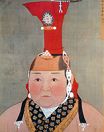
Speaking of parts west? On Mar. 1, 1260 after the Mongol forces of Hulagu Khan combine with the Franks under Bohemond VI of Antioch and the Cilician Armenians under Hetoum I and capture Aleppo, they hook up with Hulagu's Christian Turkish gen. Kitbuqa (-1260) and capture Damascus, celebrating Xmas Mass in the Grand Mosque of the Umayyads (formerly the Cathedral of St. John the Baptist), profaning numerous mosques and sacking Jerusalem; An-Nasir Yusuf is KIA by Hulagu, and the Ayyubid Dynasty (founded 1171) becomes kaput, continuing in name only, with the Muslim power center in Cairo not Baghdad or Damascus; meanwhile the death of Great Khan Mongke causes Hulagu to leave for Karakorum to help decide who will succeed him, and he leaves only 10K horsemen in Syria under Kitbuqa to occupy it, who raids as far S as Ascalon and Jerusalem, and stations a garrison of 1K in Gaza and another in Naplouse. On May 5, 1260 Kublai Khan (1215-94), grandson of Genghis Khan succeeds his brother Mongke (Mangu) as Great Khan of the Mongol Empire in N China and parts W, founding the (Great) Yuan Dynasty of China (ends 1368), after first moving the capital to the new city of Shangdu (Xanadu) while squabbling over secession; the Yuan dynastic name is officially adopted in 1271.

On Sept. 3, 1260 after the Mamluks take advantage of the absence of Hulagu to move on them, the Mongols offer an alliance with the Franks, but Pope Alexander IV forbids it, and Count Julian Grenier of Sidon (-1275) (son of Balian I and Margaret of Brienne) causes the death of a grandson of Kitbuqa, causing him to sack Sidon, pissing-off the Christians so bad tht they allow them to pass through Crusader territory, 10K-20K Egyptian Mamluks defeat and wipe out 10K Mongols in the Battle of Ain (Ayn) Jalut (Arab. "Spring of Goliath") (Heb. "Spring of Herod) in the Palestinian desert in the Jezreel Valley near Ein Harod (near Nazareth), becoming the first Mongol D that isn't avenged, forever defining the SW limit of Mongol expansion as the Tigris River; Kitbuqa is executed; Syria suffers severely from the Mongol invasion, worsened by subsequent invasions in 1281 and 1299; the Egyptians use portable hand cannon (midfa) using gunpowder cartridges charged with 2-3-15 (sulfur-carbon-saltpeter) gunpowder; on the way back to Cairo Al-Zahir al-Malik Baybars (Baibars) (Arab. "panther") (1223-77) AKA Abu al-Futuh (Abu l-Futuhat) (Arab. "father of conquest") murders Sultan Qutuz, and becomes Bahriyya sultan #1 of the Mamluk Empire (until July 1, 1277); the Kipchak Turkish Mamluks (Mamelukes) (Arab. "possessed", "owned") seize control of the Egyptian sultanate, ruling Egypt until 1517, and continuing as vassals of the Ottoman Empire until 1811, becoming known for kicking the Franks out of Palestine, and kicking the last Crusader's butt out of Asia; the Bahriyya (Bahri) Sultanate of the Mamluk Empire (ends 1382) is founded, becoming the leading Muslim state, integrating and ruling the Syrian provinces in 1271-1516 while recruiting Mamluk soldier-slaves from the Caucasus, which causes ethnic tensions between Turks and Circassians (known for their beautiful babes); Cairo becomes the richest city W of the Indus River until 1300, with public works erected by exploited peasants; the usual form of succession is assassination; Christian participation in the 1258 Mongol invasion of Baghdad et al. cause the Muslims to begin a persecution, ushering in a "devastating reversal of Christian hopes... [and] the... decisive collapse of Christianity in the Middle East and much of Africa" (Colin Chapman); by the middle of this decade Western Christians wake up and begin accepting Mongol feelers about a Franco-Mongol Alliance against the greater threat of the Muslims, the Mongols promising them Jerusalem in return for cooperation; too bad, despite several pro-Christian Buddhist Mongol khans sending embassies, it never happens, perhaps because the Christians demand their conversion first, giving Islam time to slam-dunk and convert them.
In 1262 Hulagu Khan returns and masses his armies to attack the Mamluks to avenge the 1260 D at Ain Jalut, but is drawn into a civil war with Batu Khan's brother Berke (Birkai) Khan (-1266), leader of the combined Blue and White Hordes, a Muslim convert who wants to avenge Hulagu's sack of Baghdad and allies with the Mamluks, becoming the first Mongol civil war, ending their unity; his gen. Nogai ("dog") Khan (Isa Nogai) (-1299) (great-great-grandson of Genghis Khan) begins raiding Hulagu's territories; meanwhile Hulagu sends an embassy to "all kings and princes overseas" led by his secy. Rychaldus (Richardus) to strike a Franco-Mongol Alliance against the Mamluks, but King Manfred of Sicily, who is allied with the Mamluks against Pope Urban IV intercepts and returns him; on Apr. 10 Hulagu sends a letter to French king Louis IX via John the Hungarian offering an alliance, promising them Jerusalem in return for sending a fleet to Egypt, but it either doesn't arrive or isn't answered, although John does reach Pope Urban IV, who next year sends the letter Exultavit cor Nostrum to Hulagu, telling him that Latin Jerusalem patriarch William II of Agen will investigate his desire to be baptised as a Christian via a papal rep.
On Nov. 14, 1263 grand prince (since 1236) Alexander Nevsky (b. 1220) dies in the town of Gorodets on the Volga River on his way back home from the Golden Horde, and his son Dmitri Alexandrovich (1250-94) becomes grand prince of Vladimir and Novgorod (until 1293) - kissing Mongol foot like his daddy did?
In 1263 the Polos travel with a Tatar embassy to Kublai Khan's Mongol court in Shangtu (Xanadu).

On Nov. 16, 1264 emperor (since Sept. 17, 1224) Song Li Zong (b. 1205) dies, and on Nov. 16 his nephew Song Du Zong (Zhao Qi) (nee Zhao Mengqi) (1240-74) becomes Nan Song emperor #6 of China (until Aug. 12, 1274), going on to face Mongol incursions while indulging in wine and women and leaving affairs to his incompetent minister Jia Sidao (Shixian) (1213-75); each morning all the babes he's bedded have to come pay their respects, and their number soon mounts to 30? Kublai Khan relocates his Mongol capital to Chungto (modern-day Beijing), renaming it Khanbalik (Cambaluc) ("city of the great khan") (until 1368) - did he a stately pleasure dome decree?
In 1264 Kublai Khan relocates his Mongol capital to Chungto (modern-day Beijing), renaming it Khanbalik (Cambaluc) ("city of the great khan") (until 1368) - did he a stately pleasure dome decree?

On Feb. 8, 1265 Mongol ruler (since 1256) Hulagu (b. 1217) dies on Shahi Island on Lake Urmia after conquering Persia, and is buried on Kaboudi Island in Lake Urmia, his funeral featuring human sacrifice; his son Abaqa (Abagha) ("paternal uncle") Khan (1234-82) succeeds as Ilkhanate ruler #2 (until 1282) and establishes the initially Buddhist Mongolian Ilkhanid (Il-Khanid) Dynasty in Persia, Iraq, and much of Anatolia (ends 1336), ruling as ilkhan (viceroy) #2 (until 1282), with capital initially at Maragha (Maragheh) (Maraghe) in Azerbaijan, later moved to Tabriz; much of his reign is consumed in civil wars with other Mongols of the N khanate and an invasion of Syria; the Persian Islamic bureaucracy is used to extort taxes from the pop.; the Mongol "holocaust" permanently turns agricultural land to pastoral use, and settles large numbers of Turks in NW Iran (Azerbaijan); the Jews worm their way into the admin. until the anti-Jewish riots of 1291.

On Feb. 8, 1266 Mongol ruler (since 1256) Hulagu (b. 1217) dies on Shahi Island on Lake Urmia after conquering Persia, and is buried on Kaboudi Island in Lake Urmia, his funeral featuring human sacrifice; his son Abaqa (Abagha) ("paternal uncle") Khan (1234-82) succeeds as Ilkhanate ruler #2 (until 1282) and establishes the initially Buddhist Mongolian Ilkhanid (Il-Khanid) Dynasty in Persia, Iraq, and much of Anatolia (ends 1336), ruling as ilkhan (viceroy) #2 (until 1282), with capital initially at Maragha (Maragheh) (Maraghe) in Azerbaijan, later moved to Tabriz; much of his reign is consumed in civil wars with other Mongols of the N khanate and an invasion of Syria; the Persian Islamic bureaucracy is used to extort taxes from the pop.; the Mongol "holocaust" permanently turns agricultural land to pastoral use, and settles large numbers of Turks in NW Iran (Azerbaijan); the Jews worm their way into the admin. until the anti-Jewish riots of 1291.
In 1267 the Polos travel to Kublai Khan's capital of Kaifeng; the Kublai Khan moves his winter capital to Yanjing, where he begins building Khanbalig (Cambuluc) (Peking/Beijing).
In Feb. 1269 the Mongols build a fortress E of the Han River to block the water supply, then siege the walled cities of Xiangyang and Fancheng in Hubei Province, the last two strongholds of the Nan Song (until 1273); both sides use explosives in the fighting (first time in history?).

In 1269 the Polos return from the court of Kublai Khan with a letter from him to the pope; meanwhile after Kublai Khan commissions Tibetan monk Tibetan monk Drogon Chogyal Phagpa (1235-80) to develop a new writing system for Mongol (Yuan) China, he develops the 'Phags pa script, which becomes the empire's official writing system, replacing Chinese characters and the Old Uyghur alphabet; too bad, it isn't widely accepted and falls into disuse after the collapse of the Yuan Empire to the Ming Dynasty in 1368; Phagpa is rewarded with the title of imperial preceptor next year.

Time won't let me wait that long? In 1271 Kublai Khan officially proclaims the Great Yuan (Mongol) Dynasty (ends 1368); meanwhile the Polos begin their 2nd trip from Europe to Asia (ends 1275), accompanied by Niccolo Polo's 17-y.-o. son Marco Polo (the Younger) (1254-1324), stopping in Jerusalem to get oil from the lamp of the Holy Sepulchre as requested by Kublai Khan, sailing to the SE Turkish port of Ayas, then traveling E by caravan across the entire width of Asia through E Turkey (noting that Mt. Ararat is too hard to climb), Georgia (noting "a fountain from which oil springs in great abundance", which is good for burning but no good in a salad), Armenia (with 30-lb. fat-tailed sheep), Persia (noting the cool soft Kerman "shals"), Badakhshan (seeing salt mined and rubies dug), then via camel along the S Silk Road through the Taklamakan Desert and Great Sand Sea (Gobi Desert) (noting sandstorms and mirages), visiting Balkh, the Pamir Plateau, Kashgar, Khotan, Lop Nor, Tangut, and Kanchow, homeland of the Mongols, finally reaching Chandu (Shangtu) (Xanadu), becoming the first Westerners in a generation to cross the Wakhan Corridor to China. In May Marco Polo and his party arrive at Kublai Khan's summer capital of Chandu (Xanadu) N of the Great Wall in Cathay (China), where they stay until 1292, noting that he keeps 10K milk-white horses within the walls of his summer residence; in the fall they accompany Kublai Khan to his winter capital at Peking, where they view his "stately pleasure dome" of violet, green, and vermilion on gilded walls carved with figures of dragons and Buddhas, which has a huge hall capable of entertaining 6K at dinner; the royal dude has 1M retainers, and his New Year's parade features 5K elephants each carrying two coffers of treasure; Marco pleases Kublai's ear with his own stories, and is given free run of Cathay for 17 years, observing spectacles (eyeglasses) in gen. use.

On Mar. 14, 1273 Battle of Xiangyang (begun 1267) in Hubei Province is a V for the Mongols, who capture the last Nan Song stronghold and close in on what's left of the kingdom; meanwhile minister Jia Sidao hides the fact from whoremaster emperor Song Du Zong, who soon dies happy, and is succeeded by his infant son Song Gongdi (Xhao Xian) (1271-1323), who becomes Southern (Nan) Song emperor #7 of China (until 1276), while his grandmother empress dowager Xie and his mother empress dowager Quan act as regents.
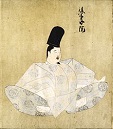
On Mar. 6, 1274 emperor (since Jan. 9, 1260) Kameyama (b. 1249) abdicates, and on Mar. 6 his cousin Go-Uda (1266-1324) becomes Japanese Yamato emperor #91 (until 1287); on Nov. 19 the Mongols under Kublai Khan attempt an invasion of Japan, but are repulsed by the samurais; too bad, Hakozaki Shrine in Fukuoka is burned to the ground, and later rebuilt with a sign reading "Surrender of the enemy nation" (Tekikoku kofuku)- try to imagine that scene?

In 1276 after crossing the Yangtze River, the Mongols capture the Nan Song city of Lin An (modern-day Hangzhou), and empress dowager Xie surrenders on the condition that her son Song Gongdi be allowed to live after being demoted to a duke, after which he is ordered in 1289 by Kublai Khan to go to Tibet to become a monk, becoming a great scholar; too bad, he writes a poem expressing his longing to become emperor, causing him to be executed in 1323; meanwhile his older brother Song Duanzong (1268-78) (along with his infant brother Bing) escapes to Fujian on Lantau Island (modern-day Kowloon City) in S China, setting up the govt. in Fuzhou, becoming Southern (Nan) Song emperor #8 of China on June 14 (until May 8, 1278).

In 1278 as Mongol forces are about to break through, Chinese emperor Song Duangzong and his minister Lu Xiufu (-1279) flee to Guangdong province, staying in Hong Kong (Chin. "fragrant harbor"); later the Song Wong Toi (Chin. "Terrace of the Song Kings") is erected in Kowloon City in commemoration; too bad, in Mar. Song Duangzong (b. 1268) falls off a boat while fleeting the Mongols and nearly drowns, dying on May 10, and his younger brother Song Zhao Bin (1271-9) becomes emperor #9 (last) of the Nan (Southern) Song Dynasty in China (until 1279).
On Mar. 19, 1279 the Yuan Dynasty of Kublai Khan finishes off the Southern (Nan) Song Dynasty in China (founded 1127) at the Battle of Yamen, where emperor Song Zhao Bin is either KIA or escapes with the fleet of adm. Zhang Shijie across the sea, and founds the Luzon (Lu Song) (Lesser Song) Empire; Lu Xiufu jumps off the cliffs of Mt. Yashan; Kublai Khan sends an emissary to the Vietnamese emperor in Thang-Long (Hanoi) demanding surrender, and when he refuses he begins a war (ends 1288).
In 1281 the Mongols invade Syria again (first time 1260).
In 1281 after returning to Japan and finding no suitable landing beaches because of defensive walls, a kamikaze (Jap. "divine wind") (typhoon) destroys Kublai Khan's fleet of 4.5K vessels and 150K men from Korea and the lower Yangtze Delta (largest naval invasion until D-Day in 1944) at Hakozaki Bay in Fukuoka, thwarting his invasion of Japan as in 1274, and causing the Japanese to later use the word kamikaze for their suicide bombers.
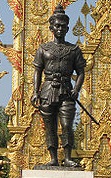
In 1281 Thai king Mangrai (Mengrai) (1238-1311) conquers the kingdom of Haripunjaya at Lamphun, going on in 1292 to found the Buddhist kingdom of Lan Na (Lannathai), centered at Chiengmai (Chiang Mai) in N Thailand, which fights off Mongols from the N for the next two decades.
In 1281 20 years after setting out from Yuan China on a pilgrimage to Jerusalem, only to get holed-up in Baghdad instead, where they are welcomed by Nestorian patriarch Denha I, Turkish Chinese monk Rabban Bar Sauma (Sawma) (1220-94) and his student Rabban Markos return to Maragheh after Markos is elected Yaballaha III, patriarch of the Nestorian Church, and in 1278 he sends his former teacher to Rome to negotiate an entente between the Nestorian and Roman Catholic churches and form a strategic Franco-Mongol alliance against the Muslim Mamluk sultanate in Cairo, arriving after the death of Pope Honorius IV and negotiating with the cardinals instead, proceeding to Genoa then Paris, where he spends 1 mo. with Philip IV the Fair, then to Gascony, where he meets Edward I of England in Bordeaux, who is enthusiastic but begs off due to conflicts with the Scots and Welsh; he then returns to Rome, where new Pope Nicholas IV gives him communion on Palm Sun., 1288 before returning to Baghdad; Bar Sauma writes an account of his travels giving the viewpoint of the East on the West, beating Marco Polo.
In 1282 a Mongolian army sent in ships from S China seizes the capital of the Hindu kingdom of Champa (Tsiompa) in coastal Vietnam (until 1283).
On Apr. 4, 1287 as the Mongols invade Burma, the Theravada Buddhist Hanthawaddy Pegu Kingdom in Lower Burma (ends 1552) is founded by King Wareru (1253-1307), with capital at Martaban (Mottama).
In 1287 the Mongols led by Khan Talabuga and Nogai Khan invade a-one-and-a-two-and-a-3-a (3rd time) Poland, ravaging Lublin, Mazovia, Sandomierz, and Sieradz; Leszek the Black flees to Hungary; the Mongols are defeated and fail to take Cracow (Krakow).
In 1287 the Polos accompany Kublai Khan on an expedition to destroy his uncle Nayan; Kublai has 260K cavalry and 100K infantry, while Nayan has 400K horsemen; the Mongols invade Champa and Vietnam (until 1288), and Burma (Pagan), where Narathihapate has just died, winning the Battle of Pagan in Dec., ending the Pagan Empire, which disintegrates into smaller kingdoms; Lanna King Mangrai and Sukhothai King Khamhaeng agree to a peace in Thailand. Egyptian Mamluk sultan Al-Mansur Qalawun captures the port city of Latakia in Syria; meanwhile Mongol ilkhan Arghun sends Beijing, China-born Nestorian monk-traveler-diplomat Rabban Bar Sauma (Sawma) (Cauma) ("son of fasting") (1220-94) (of Turkic Uyghur origin) from Baghdad to the leaders of Europe with a large retinue and 30 riding animals to negotiate an alliance against the Mamluk sultanate, witnessing the naval Battle of Sorrento Bay, then visiting Rome and receiving communion from new pope Nicholas IV on Palm Sun. 1288 before returning to Baghdad in 1288 without success, then writing his memoirs, which give an alternative view of Kublai Khan compared to Marco Polo, along with a Chinese view of Europe, causing him to become known as "the Reverse Marco Polo".
In 1288 the Mongols invade Turkey and Asia Minor.
In 1288 the Vietnamese turn into guerrilla fighters, cut off the Mongol supply lines, and kick their butts out of the country.
In 1288 the Slave Dynasty of Delhi (founded 1206) ends, and in 1290 is succeeded by the Muslim Khilji (Khalji) Dynasty (ends 1320), starting with Jalal-ud-din Khalji (Firuz) (1226-96) (until July 19, 1296), becoming the 2nd dynasty to rule the Delhi Sultanate of India, going on to make conquests in S India while fending off the Mongols and converting some of them to Islam.
In 1288 Chinese soldiers use Heilongjiang bronze hand-held cannon to fight the Mongols in Manchuria; the Chinese have 3K cast bronze and iron cannon mounted on the Great Wall of China; the oldest cannon to survive to modern times dates to this year, and has a muzzle bore diam. of 1 in.; the 2nd oldest is from 1332 (4 in.).

In 1289 King (since 1269) Leon III (b. 1236) dies of arsenic poisoning, and his Frankish Christian son Hetum (Hethum) II the One-Eyed (1266-1307) becomes king of Mongol-controlled Lesser Armenia (Cilicia) (until 1293, then 1295-6, and 1299-1303), writing a Chronicle of Armenia.
On Feb. 1, 1290 Mamluk sultan #10 (since 1287) Kaikobad is murdered by a Khilji (Khalji), and Jalauddin (Jalal ud din Firuz Khilji) (-1296) becomes sultan #1 of the Muslim Turkic Khilji (Khalji) Dynasty in N India (ends 1320), ruling from Kilughari near Deli, becoming the 2nd dynasty to rule the Delhi Sultanate, going on to raid into S India and defend against repeated Mongol invasions while becoming known for faithlessess and ferocity.
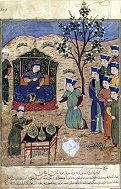
On Mar. 5, 1291 after Arghun Khan grows ill and anti-Jewish riots begin in the Ilkhanid Mongol state in Persia and Iraq (where Jews had figured in the Mongol admin. from the start), Jewish grand vizier (physician) Sa'ad al-Dawla (b. 1240) (Arab. "felicity of the empire") is murdered along with his Jewish associates, and Jews are purged from the Mongol admin.; on Mar. 7 paralyzed pro-Christian Buddhist khan #4 (since 1284) Arghun Khan (b. 1258) is murdered by Mongol cmdr. Ta'achar, and by his nomination his brother Gaykhatu ("amazing/surprising") (-1295) becomes Mongol Ilkhanid khan #5 of Persia (until 1295), becoming known for his dissolute lifestyle incl. wine, women, and sodomy with boys; meanwhile after Arghun loses his favorite wife Bolgana (-1286), and asks his granduncle Chinese emperor Kublai Khan to send him one of her relatives as his new bride, Marco Polo, after 17 years in the service of Kublai Khan and after visiting Indochina, Burma, and Tibet, and serving three years as gov. of Yangchow province returns with his family to Italy, setting out next year from the port of Zayton in boats specially fitted out at the emperor's orders (arrives 1295), visiting Java, Sumatra, Singapore, Ceylon, and the Persian Gulf, accompanying 17-y.-o. princess Kokotchin (Kokochin) (Celestial/Blue Dame) to Persia before returning to Venice via Trebizond (by land) and Constantinople; too bad, the journey to Persia takes two years and Arghun dies, so she marries Arghun's son Ghazan instead.
On Apr. 4-May 18, 1291 the last Crusader (Frankish) state of Acre (Saint-Jean d'Acre) (Akka) in Syria is sieged and captured by the Mamluks, followed in May by Tyre; the Christian Crusades (begun 1095) end miserably with the expulsion of the Crusaders from the Middle East (Palestine), and the Mamluks in control of all of Egypt and Syria; Pope Nicholas IV calls upon all Christian princes to pray for all the needless deaths, er, take up arms against the Muslims one more time, and for synods to discuss the advisability of uniting the Knights Templar and the Knights of St. John, whose catfights he partly blames for the loss of the Ptolemais; in Aug. he sends a letter to Persian Mongol khan Arghun informing him of plans of Edward I of England to lead another Crusade to recapture the Holy Land, stating that it could only be successful with the help of the "powerful arm" of the Mongols, and asking Arghun to receive Christian baptism and march against the Mamluks; after Arghun dies in Mar. 1291, followed by Nicholas IV in Mar. 1292, Edward I sends Geoffrey de Langley to Persian Mongol khan Gaikhatu, leaving from Genoa and arriving in Tabriz, then returning to Genoa; "Had the Mongol alliance been achieved and honestly implemented by the West, the existence of Outremer would almost certainly have been prolonged; the Mameluks would have been crippled if not destroyed; and the Ilkhanate of Persia would have survived as a power friendly to the Christians and the West" (Sir Steven Runciman, A History of the Crusades, p. 402); meanwhile the Knights of St. John are transferred to conveniently-located Cyprus; too bad, the Templars end up back in Europe with no coverstory and too much land and wealth, causing a ton of pissed-off royals who owe them money to get ideas? - they got sixteen years left?

On Feb. 18, 1294 Chinese Mongol emperor #1 (since Dec. 18, 1271) Kublai Khan (b. 1214) dies after killing 18M Chinese, and on May 10 he is succeeded by his grandson Temur Oljeitu (1265-1307) as Yuan emperor #2 of China (until Feb. 10, 1307).

Marco Polo, that Christian, he's a wuss? In 1295 Gaykhatu is strangled by a bowstring to make it bloodless, and his Muslim cousin Baydu (Baidu) (-1295) becomes Mongol Ilkhanid khan #6 of Persia, becoming sympathetic to Christianity and permitting churches, but is assassinated near Tabriz on Oct. 4 by Hulagu's Christian-raised great-grandson (descendant of Mangu) Mahmud Ghazan (1271-1304), who becomes Mongol Ilkhanid khan #7 of Persia (until May 11, 1304), taking the title Yuan Chen Zong, Yuan emperor of China, converting to Sunni Islam and dumping Christianity because it is the "stronger" religion, making it the official religion and changing his name to Mahmud, although that doesn't stop his war with the Muslim Mamluks; with his grand vizier (1298-1318) (a Jewish physician who wisely converts to Islam) Rashid al-Din Hamadani (Tabib) (1247-1318) he attempts to reform the govt., stop overtaxation, restore agricultural land, and integrate the Mongols into the supremacist Islamic mindset, starting by showing them Islam's violent side by destroying Buddhist temples and going back to tried and true restrictions on the rights of pesky Christians and Jews.

In 1297 the Seljuk Turks under bey (since 1280) Osman (Osmanli) (Othman) I Gazi ben Ertugrul (Kara) (the Black) (El-Bazi) (1258-1326) (black meaning he attained the highest degree of manly beauty, and and Osman meaning bone-breaker), whose father Ertugrul (-1280) was leader of the Turkic Kayi tribe, who fled from the Mongols W from C Asia to W Anatolia and pledged alliance to Seljuk Sultan Kayqubad I in return for a beylik overrun Bithynia on the S shores of the Black Sea, but cannot conquer all of the fortified cities.

My mind's such a sweet thing, crimson and clover, over and over? In 1298 Italian world traveler Marco Polo (1254-1324) is captured in battle and thrown in jail in Genoa, which gives him the leisure to write up his cool travels, and he begins dictating his memoirs to his cellmate, incl. a sherbet recipe brought home from Asia, finishing ca. 1300; it takes until 1447, but finally A Description of the Marvels of the World (The Travels of Marco Polo), AKA (by his many doubters) Il Milione (The Million Lies) (The Marco Millions) is pub.; it describes heating coal ("black stones"), oil lamps, asbestos, Chinese scholars wearing eyeglasses, crocodiles, yaks ("grunting oxen"), coconuts, how emperor Kublai Khan's harem is filled with 100 new concubines every two years by special emissaries, the Pacific Ocean, his route across the Asian continent and all the cool wonders and sights, the interior workings of unsaved China, everything except tea, foot binding, and the Great Wall of China?; on the other hand, he claims that a prince "sixth in descent from Prester John" rules a territory W of Peiping (Peking); although there really is a Kublai Khan who rules from Siberia to the Punjab, and he really did go away from age 17-40 and mainly tell it like it is, it takes cents. for him to be believed by members of the Holy Mother Church and its infallible Pope with a pipeline to Christ and God; the stories introduce Japan, Peking, Java, Sumatra, Siam, Burma, Ceylon, the Zanzibar Coast, Madagascar, and Abyssinia to the West, inspiring commerce and travel,
On Dec. 22-23, 1299 after the Mongols invade Syria again (last time 1281) with an army of 10K Mongols and 10K Georgians and Armenians, and cross the Euphrates River and seize Aleppo, they win the Third Battle of Homs (Wadi al-Khaznadar) against 60K-90K Mamluks from Damascus, whose banner features a Star and Crescent Moon, which is later erroneously claimed to be adopted by Muslims after taking Constantinople in 1453; the Mongols lose 5K-14K KIA vs. 40K-50K Mamluks KIA; the Mamluks flee S towards Damascus while being harassed by 12K Marionite and Druz bowmen seeking independence; the Mongols sack Damascus and seige the citadel (until 1300); Al-Nasir Muhammad (1293-4) reascends the throne as sultan of the Mamluk empire (until 1309).
In 1300 world population decreased from 400M in 1250 to 392M (vs. 393M in 1200), becoming the first known time that it decreased (until ?), due to the super-cruel-and-bloody Mongol expansion.
In 1300 the Mongols invading Syria and sieging Damascus retreat across the Euphrates River to face an invasion by the Chagatai Khanate led by Khan Kaidu (1230-1301), who is defeated and KIA near Karakorum next year; the Marionites and Druzes fail to keep control of Syria and Palestine, which is soon retaken by the Mamluks; meanwhile Harran-born Islamic scholar Ibn Taymiyyah (1263-1328), who preaches a puritan bare-bones form of Islam for Salafis (Arab. "Salaf us Saleh" = righteous predecessors) that eschews foreign innovations (Arab. "bid'a") issues a fatwa declaring that jihad upon the Mongols is obligatory even though they converted to Islam because they rule under the manmade Yassa Code of Genghis Khan rather than Sharia; it takes cents. for his teachings to give birth to Wahhabism.
On Apr. 20-22, 1303 the decisive Battle of Marj al-Saffar (Shaqhab) near Kiswe, Syria (S of Damascus) ends the Mongol threat to the West, saving Syria for the Mamluks, and Europe for Christianity?; the Mongols come and go in 40 years after turning Asia from 100+ thriving cities into a poverty-stricken hellhole, which continues to modern times.
In 1306 Mongol noblewoman-wrestler Khutulun ("moonlight") (AKA Aigiarne, Aiyurug, Khotol Tsagaan, Ay Yaruq) (b. 1260). daughter of Kaidu, cousin of Kublai Khan dies after offering to marry any man who could defeat her in wrestling, on condition that they pay her 100 horses if she wins, dying with 10,000 horses.


On Feb. 10, 1307 emperor #2 (since May 10, 1294) Temur Oljeitu (Yuan Chen Zong) dies, and on June 21 his nephew Khaisan (Khayishan) ("wall") succeeds as Mongol Yuan emperor #3 of China, taking the title Yuan Wu Zong (1281-1311) (until Jan. 27, 1311), with Oljeitu's widow Khatum Bulugan (Buluqhan) (Zibeline) (-1286) as regent; seven Mongol emperors rule China between this year and 1333.
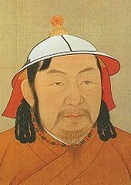
On Jan. 27, 1311 emperor #3 (since June 21, 1307) Yuan Wu Zong (b. 1281) dies, and on Apr. 7 his brother Ayrubarwada becomes Yuan Ren Zong (Buyantu Khan) (Blessed Khan) (1285-1320), Mongol Yuan emperor #4 of China (until Mar. 1, 1320), becoming the first to actively support adoption of Confucian principles into the admin. system incl. the civil service exams. In 1315 the Chinese civil service exams are reinstated by the Mongols, with built-in discrimination in favor of Mongols and their non-Han supporters against the Hans.
In 1315 Sultan Alauddin of Delhi dies just as the Mongols are beginning to infiltrate the N frontiers of his Muslim domain.
On Dec. 16, 1316 Muslim Mongol Persian khan #8 (since July 13, 1304) Oljeitu (b. 1280) dies in Soltaniyeh, leaving a magnificent tomb, and his son Abu Sa'id (Sayed) Bahador (Behauder) ("hero") (1305-35) becomes Persian Mongol Ilkhanid khan #9 (until Dec. 1, 1335), the last before the empire disintegrates.
In Apr. 1318 a group of Franciscans led by Odoric of Pordenone (Odorico Mattiussi or Mattiuzzi) (1286-1331) incl. James of Ireland leave Padua, Italy on a mission to the East (ends 1330), taking them to Venice, Constantinople, Trebizond, Armenia, Media, Persia incl. Kashan, Yazd, Persepolis, and Shiraz, India (Thane near Mumbai), Sumatra, Java, Borneo, Champa, Guangzhou, Quanzhou, Zhejiang, Hangzhou, Nanjing, and Khanbaliq (modern-day Beijing) in 1324-7, returning via the Land of Prester John (Mongolia), Casan, Tibet, N Persia (incl. Tabriz) to Venice; in 1328 Odoric becomes the first Euro to visit Tibet - the original Pordenone's Complaint?
On July 13, 1318 Persian Ilkhanid minister (since 1298) (a Jew who converted to Islam) Rashid al-Din Hamadini (b. 1247) is beheaded after his rival Amir Chupan (Choban) (-1327) gets him framed on trying to poison Oljeitu Khan, and takes his job as grand vizier.

On Mar. 1, 1320 emperor #4 (since Apr. 7, 1311) Buyantu Khan (Yuan Ren Zong) (b. 1285) dies, and on Apr. 19 his eldest son Shidebala becomes Geegan ("enlighttened") Khan (Yuan Ying Zong) (1302-23), Mongol Yuan emperor #5 of China (until Sept. 4, 1323).
In 1322 the Persian Mongols under Abu Sai'd and his grand vizier Chupan sign the Treaty of Aleppo with the Mamluks, ending their invasions of Syria (begun 1260), and the Crusaders are out of luck about a Franco-Mongol alliance against them.
In 1322 English knight John de Mandeville (-1372) (born in St. Albans) begins a journey to Egypt, the Holy Land, India, and China, serving 15 mo. in the army of the Mongolian great khan before returning in 1356.

On Sept. 4, 1323 after instituting anti-corruption reforms and siding with the Tibetan Buddhists against Muslims, emperor (since 1320) Shidebala (Yuan Ying Zong) is assassinated, becoming the first Mongol ruler to be assassinated, and on Oct. 4 is succeeded by Yesun Temur, who becomes Yuan Tai Ding Di (1293-1328), Mongol Yuan emperor #6 of China (until Aug. 15, 1328).
In 1323 the Mamluks sign a peace treaty with the Ilkhanids (1328?).
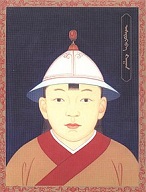


On Aug. 15, 1328 Yuan emperor #6 (since Oct. 4, 1323) Yesun Temur (Yuan Tai Ding Di) (b. 1293) dies, and on Oct. 4 is succeeded by his eldest son Ragibagh (Arigabag), who becomes Yuan Tian Shun (1320-8), but on Nov. 14 before he can be coronated he is dethroned by is succeeded by 24-y.-o. Tugh Temur (Jayaatu "lucky" Khan) (1304-32), who becomes Mongol Yuan emperor #7 of China, then abdicates after 1 mo. in favor of his elder brother Khoshila (Kusala), who on Feb. 27, 1329 becomes Khutughtu Khan (1300-29), Mongol Yuan emperor #8 of China Mingzong (until Aug. 30, 1329), who resigns on Aug. 30 in favor of Tugh Temur, who resumes the throne on Sept. 8, 1329 (until Sept. 2, 1332); Eretna Bey (-1352) becomes Mongol Ilkhanid rep. in Rum; the War of the Two Capitals begins, pitting the family dynasty based in Khanbaliq (modern-day Beijing) against the one based in the summer capital Shangdu, which ends in 1332 with a V for the Khanbaliq group after the most bloody and destructive succession struggle in Yuan history.
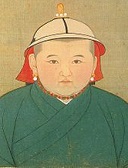

On Sept. 2, 1332 Yuan emperor #7 (since Oct. 16, 1328) Tugh Temur (b. 1304) dies, and on Dec. 14 his younger brother Rinchibal becomes Yuan Nin Zong (1326-32), Yuan emperor #8, dying prematurely on Dec. 14; next July 19 he is succeeded by Toghon Temur, who becomes Yuan Hui Zong (Sun Di) (Shun Di) (1320-70), Mongol Yuan emperor #9 (last) of China (until 1368), stirring revolt by starting a strong anti-Chinese program after drought, famine, floods, and plague kill 5M in China in 1333, followed in 1334 by the Black Death, which strikes China's NE Hopei Province, then sweeps along the trade routes to Europe by 1347; by 1351 it kills 20M-30M in Europe (a third of Europe's pop., and up to 60% in some areas), and 75M worldwide by 1361; world. pop. decreases from 450M to 350M-375M by 1400; Europe takes 150 years to return to 1347 pop. levels; it ravages China, halving its pop. from 123M in 1200 to 65M in 1400.
On Dec. 1, 1335 Persian Mongol Ilkhanid khan (since 1316) Abu Sa'id (b. 1305) dies in Soltaniyeh without an heir or appointed successor, after which the Ilkhanid Dynasty (founded 1256) quickly disintegrates into competing provincial states in Iran, Iraq, and E Anatolia, until Turcoman Timur mops them up in the 1380s-90s: the Muzaffarids in Shirz, the Karts in Herat, the Shiite Sarbvadars in Sabzavar in E Iran, the Dulkadirs on the upper Euphrates, and the Jalayirids in Iraq and Azerbaijan with capital in Baghdad; Eretna of Rum (of Uyghur origin) declares himself sultan of his own Principality of Eretna in NE Anatolia (ends 1381).
On Apr. 9, 1336 Turco-Mongol conqueror ("Lord of the Fortunate Conjunction") ("Emperor of the Age") ("Conqueror of the World") (Sunni Muslim) Tamerlane (Timur the Lame) (Tamburlaine) (Timur-i Lang) (Timur Lenk) (Timur Leng) (Tamerlano) (d. 1405) (Chaghatay "temur" = iron) is born near Kesh (50 mi. S of Samarkand) in Transoxiana (modern-day Uzbekistan); born into the Turkish-speaking Sunni Muslim Mongol Barlas clan; claims descent from Ali, son-in-law of Muhammad and mythical Mongol queen Alanquoa; husband of Zenocrates; in 1363 he tries to steal sheep but is shot by two arrows from the shepherd, in the right leg and right hand (losing two fingers), crippling him for life; speaks Persian, Mongolian, and Turkish; motto: "Rasti rusti" (Lat. Veritas salus) (Truth is safety); likes to play polo with enemy skulls, erecting 30-ft.-high skull pyramids to celebrate Vs; grandfather of Ulugh Beg (1394-1449); great-great-great-grandfather of Babur (1483-1530).
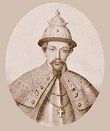
On Mar. 31, 1340 grand prince (since 1328) Ivan I (b. 1288) dies, and on Mar. 31 his eldest son Simeon Ivanovich (Gyordi) (the Proud) (1316-53) becomes grand prince of Moscow (until Apr. 27, 1353), claiming the title of prince of all Russia (until 1353), and going on to take on the pesky Lithuanians, using an old treaty with their allies the Mongols to make the Mongol khan give him some Lithuanian POWs to use as hostages.
In spring 1346 a severe epidemic of plague begins in the Crimea, depopulating several Mongol towns by Nov., and forcing the Golden Horde to withdraw from the siege of Kaffa (Feodosia) (Theodosia) next year, after which Europeans fighting with the Tartars return to Europe, carrying the plague with them, while others carry the plague to Constantinople and ARabia.
In 1351 there is massive flooding of the Yellow River in China; Liu Futong leads the rebel Red Turban Army in Yin Zhou (created by Guo Zixing from followers of the White Lotus in response to the Black Death) in a successful rebellion against the Mongol Yuan Dynasty (ends 1368).
In 1356 the Mongols under Jani Beg invade Azerbaijan and take the city of Tabriz, establishing their own gov.
In 1357 Jani Beg is assassinated, and Berdi Beg (Berdibek) (-1359) becomes khan of the Mongol Golden Horde (until 1359).
In 1357 the Ispah (Persian Sepoy) Rebellion (ends 1366) in Fujian, China sees a Mongol army of mainly Arab and Persian Muslims revolt against the Yuan Dynasty, occupying Quanzhou (Chinchew) (Zaiton) on the SE coast of China beside the Taiwan Strait, alng with Putian, threatening Fuzhou until it collapses in 1362 and is crushed by Han Chinese cmdr. Chen Youding.
In 1359 Berdi Beg is assassinated by his brother Qulpa (-1360), who becomes khan of the Golden Horde until next year, when another brother assassinates him, after which the Mongol horde begins to fracture, with 23 more khans by 1378.
In 1368 Tamerlane (Timur) ascends the throne of Samarkand (until 1405).

The plague was actually good for Chinese? In 1368 Chinese peasant (former Buddhist monk) Zhu Yuanzhang (Yuan Zhang) (Chu Yuan-chang) (1328-98) leads Chinese rebels from S China to capture Guangzhou, causing Mongol ruler (since Dec. 19, 1332) Toghan Temur to flee to Kai Ping (Karakorum); the Yuan Dynasty (founded 1271) ends, and the Ming (Chin. "luminous") Dynasty (ends 1644), vased, er, based in the new city of Nanjing (Nanking) (Chin. "southern capital") begins (ends 1644), becoming the first reunion of China by the S (next time is the Communists in 1948); on Jan. 23 Zhu Yuan Zhang takes the title Ming Taizu (Tai Tzu) (T'ai Tsu) (1328-98) of the Hong (Hung) Wu (Chin. "vast military") becomes Ming emperor of China #1 (until June 24, 1398), with the motto: "Exiling the Mongols and restoring the Han", going on to end the Confucian view of the military as inferior to scholars; in Sept. the Mongols flee their capital of Khanbaliq (modern-day Beijing) along with the rest of N China and retreat to Mongolia; Ming Taizu promulgates the new Ta (Da) Ming Lu (Chin. "Immutable Laws") law code (completed in 1397), and restore the Great Wall of China, along with a gen. policy of isolation, while the introduction of Western foodstuffs such as wheat and yams causes a 50% pop. increase during his 30-year reign; too bad, he doesn't like merchants, and introduces paper currency, running the presses until he creates inflation.
In 1369 the Mongols force the Yuan Dynasty to flee to He Lin (Karakorum).

In 1370 with visions of Genghis Khan dancing in his head, Turkic Mongol warlord Tamerlane (Tamburlaine) (Timur-i Lang) (Timur Lenk) (Timur Leng) (Temur the Lame) (Tamerlano) (1336-1405) ("timur" = iron) gains control of the W Chagatai Khanate, going on to campaign across W, S, and C Asia, followed by Caucasus and S Russia, going on to becoming the most powerful ruler of the Muslim World and found the short-lived Timurid Empire. On Dec. 17, 1398 Tamerlane conqueres Delhi, India, sacking it and massacring the Hindu pop. in cold blood like er, cows, this is the ultimate Muslim religious experience. In his own words "In a short space of time all the people in the Delhi fort were put to the sword, and in the course of one hour the heads of 10,000 infidels were cut off, the sword of Islam was washed in the blood of the infidels, and all the goods and effects, the treasure and the grain which for many a long year had been stored in the fort became the spoil of my soldiers... Their women and children and their property and goods became the spoil of the victors. I proclaimed throughout the camp that every man who had infidel prisoners should put them to death, and whoever neglected to do so should himself be executed and his property given to the informer. When this order became known to the ghazis of Islam, they drew their swords and put their prisoners to death. One hundred thousand infidels, impious idolaters, were on that day slain. Maulana Nasiruddin Umar, a counselor and man of learning, who in all his life had never killed a sparrow, now, in execution of my order, slew with his sword fifteen idolatrous Hindus, who were his captives.... On the great day of battle these 100,000 prisoners could not be left with the baggage, and that it would be entirely opposed to the rules of war to set these idolaters and enemies of Islam at liberty... No other course remained but that of making them all food for the sword." What happened to Miranda rights and civilian trials with Jewish defense attorneys? And you thought Hitler was bad, or the Crusades or Inquisition. Imagine a Tamerlane Century 21 in America. After what Islam did to it, Delhi took a century to recover, and only after they realized that there were too many to slaughter did the Muslim clergy devise the fiction that Hindus are People of the Book.
In 1372 Chinese emperor (since 1368) Ming Taizu orders the release of all people enslaved by the previous don't-make-a-grown-man-cry Mongol regime; the king of Okinawa pledges allegiance to Ming Taizu, opening Okinawa to trade; it remains a tributary of China for 500 years.
On Aug. 11, 1378 the Battle of the Vozha River is a V for the Russians under Dmitri Donskoi over a Mongol Golden Horde army sent by Khan Mamai to punish them for increasing their power in disobedience, becoming the first major V by the Russies over the Golden Horde, exposing the vulnerability of the Tatar cavalry.
In 1379 a 2nd poll tax is levied in England, which proves as unpopular as the first (1377).
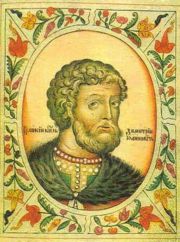
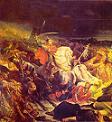
On Sept. 8, 1380 after they decide not to pay the annual tribute, drawing an invasion, the Russians under Moscow grand prince (since 1359) (St.) Dmitri II Donskoi (1359-89) win a V against the Tartar Golden Horde under Khan Mamai at the Battle of Kulikovo (Kulikov) on the Upper Don River 200 mi. S of Moscow, becoming the first Russian V since the Mongol Conquest, although the Mongols return two years later to capture Moscow and put it under the Tartar Yoke, and continue to have the upper hand for the next cent.; the Lithuanian army under Jagiello agrees to aid Mamai, but reneges at the last minute, becoming the decisive factor; Dmitri II gets the name Donskoi ("of the Don") for the big V; after rival gen. Tokhtamysh (-1406) dethrones and kills Mamai, the Russian Orthodox Church begins celebrating a memorial for the battle on the Sat. before the Feast of St. Demetrius (d. 306); after learning that he rushed N to talk Jagiello into betraying Mamai, Dmitri II flops on Cyprian, inviting him to become metropolitan of Moscow, and imprisoning Pimen.
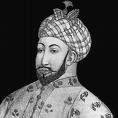

In 1381 Sunni Muslim C Asian Turco-Mongol-Persian military adventurer Tamerlane (Timur-i-Lang) (Temur the Lame) (1336-1405) ("timur = iron) (not really lame?) begins 35 successful campaigns to Persia, Russia, Georgia, Syria, Egypt, and other parts, first conquering Persia and its capital Herat; the Shiite Sarbadar regime based in Sabzavar comes under his suzerainty; Tamerlane goes on to establish an empire in Persia, Iraq, and Syria, with capital in Samarkand in modern-day Uzbekistan.
In 1382 the Mongols under Tokhtamysh capture Moscow in a surprise attack, sack and burn it, and get Dmitri Donskoi to flop and pledge allegiance and restore the tribute payment - gimme your white wimmin?
In 1479 Dayan ("Great Yuan") Khan (Batumongke) (1464-1517) reunites the Mongols in Mongolia, becoming the Khalka Mongols, the largest subgroup of Mongols in Mongolia since the 15th cent. (modern-day pop. 3M).
In Nov. 1480 after grand prince (since 1462) Ivan III the Great (1440-1505) of Moscow tells the Tartar Great Horde Khan Akhmat to stuff it and refuses the customary tribute payment, causing Akhmat to pass through the Lithuanian territories of his ally Casimir IV to the Muscovite border on the Ugra River, Ivan II makes use of artillery to defeat his horseback archers and turn them back, ending Moscow's subservience to the Tartars.

Babar conquers North India and turns it into a Tower of Babel? In 1525 Muslim Turkish Mongol chief (5th-gen. descendant of Tamerlane) Babar (Babur) (Baber) ("Tiger") (Xahir-ud-Din Muhammad) (1483-1530), prince of Ferghana in Afghanistan marches through Afghanistan and Persia, headed for the Punjab. On Apr. 20-21, 1526 the First Battle of Panipat sees the Delhi Sultanate under Ibraham Lodi defeated by Turkic Muslim Babar (Babur) (Baber) ("Tiger") (Xahir-ud-Din Muhammad) (1483-1530), who occupies Delhi and Aghra and becomes emperor #1 of the Mughal (Mogul) Empire in N India (until Dec. 26, 1530), which peaks at 4M sq. km, making it the 2nd largest after the Maurya Empire (5M sq. km), founding a line that "builds like giants and finishes like jewelers", adopting Hindustani (derived from an obscure dialect of Western Hindi, which, along with Eastern Hindi is derived from Prakrit) as its official language; religious toleration is allowed, and the Muslims introduce Arabic and Persian words and form the subdialect of Urdu, written in a Persian script, pissing-off "patriotic" Hindus, causing them to create the artificial subdialect of Hindi (different than the Western Hindi language, parent of Hindustani), purging the Muslim words and substituting Sanskrit, and writing it with the Devanagari script, causing a Hindustani subdialect war in India.
In 1619 the Dzungar ("left wing") Khanate is founded in Dzungaria (Zungaria) (Jungaria) in modern-day Xinjiang (Beijang), China, which stretches from the W end of the Great Wall of China to modern-day Kazakhstan, and from modern-day Kyrgyzstan to S Siberia, becoming the last major nomadic empire remaining from the kaput Mongolian Empire.
In 1687 the Dzungar-Qing Wars begin between the Dzungar Khanate in Mongolia and the Qing Dynasty of China, ending in 1757 with the Qings incorporating Outer Mongolia.
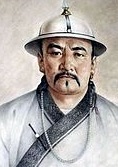
On June 12, 1696 the Battle of Jao Modo (Zuunmod) (Hundred Trees) on the Upper Terelj River 37 mi. E of modern-day Ulaanbattar sees a 30K-man Dzungar-Mongol army under well-educated Buddhist Galdan Boshugtu Khan (1644-97) defeated by a 50K-man Qin army under the personal command of the Kangxi Emperor, pushing the Dzungar Mongols to Inner Asia until their final defeat in 1758.
In 1899 Przewalski's Horses from Mongolia are brought to the Askaniya-Nova Biosphere Reserve in S Ukraine; they become extinct in the wild in the 1960s, and in 1992-3 21 horses are shipped back.

The first time since the Mongols that an Asian military force totally defeats a European power? On Feb. 8, 1904 (10:30 p.m.) "World War Zero", AKA the Russo-Japanese War (ends Sept. 5, 1905) over control of Manchuria and Korea begins with a surprise Japanese attack on the Russian naval squadron at Port Arthur (Lushun) in Liaodung Province (leased to Russia by China), followed by a formal declaration of war by Japan on Feb. 10 (the U.S. doesn't learn a lesson from this?); the Japanese, led by field marshal (since 1898) Prince Iwao Oyama (1842-1916) immediately occupy Seoul, and force Korea to annul all concessions made to Russia.

In 1910 Am. naturalist Roy Chapman Andrews (1884-1960) begins exploring the East Indies on the USS Albatross, going on to become the first real-life Indiana Jones, visiting the Arctic, China, and Mongolia, and coining the term "Outer Mongolia" for any place that's hard to reach.






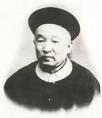
On Oct. 10, 1911 the 1911 Xinhai (Hsin-hai) (Chinese) Rev. (Rev. of the Young Chinese) against the Manchu Dynasty begins when the rev. HQ of the Wuchang org. is discovered plotting against the central railway admin. of Sheng Xuanhuai (1844-1916), and spreads rapidly and bloodily through the W and S; in early Oct. Dr. Sun Yat-sen (Zhongshan) (1866-1925) visits the U.S. to raise money from Chinese immigrants; on Oct. 10 he checks into Denver, Colo.'s Brown Palace Hotel, Rm. 321 (later the Coronet Room), raising $500; he returns to China the next day after reading newspaper headlines saying "Chinese Revolt is Menace to Manchu Dynasty" (Rocky Mt. News), and "Foreigners Throughout Empire in Deadly Peril" (Denver Post); ever after Chinese tourists stop by to see his signature in the guest register; the provinces begin seceding from the Qing Dynasty and join the rev., incl. Jiangsu on Nov. 3, Sichuan on Nov. 22, and Shandong on Dec. 12; after hearing of a program to colonize Mongolia with Han Chinese, the Outer Mongolian Rev. of 1911 begins, bloodlessly becoming independent of the Manchu-run Qing Dynasty during the 1911 Chinese Xinhai Rev.; on Oct. 14 former Korean resident Yuan Shikai (Shih-K'ai) (1859-1916) is recalled to military command by the Manchu court, and on Nov. 8 is elected PM of the provisional nat. assembly; on Dec. 4 he signs a truce with rebel gen. Li Yuanhong (1864-1928), and sends Tang Shaoyi (1862-1938) as his rep. to negotiations in Shanghai; on Dec. 30 Dr. Sun Yat-Sen, back from the U.S. and Europe is elected provisional pres. of the new Repub. of China (1912-49) by delegates from 16 provinces meeting in Nanking (Nanjing); the Manchu (Great Qing) Dynasty in China (in power since 1644) abdicates; Sun Yat-Sen appoints Gen. Chiang Kai-shek (1887-1975) as his military adviser, with "Dragon Lady" Madame Chiang Kai-shek (Mayling Soong) (1897-2003) waiting in the wings; the calendar is reformed, pigtails are abolished, and (a little late, after 4.5B women's feet are ruined?) foot binding (the golden lotus) is finally outlawed; polygamy begins to decline as marriages for love become common - come all you young maidens and listen to me, never place your affections on a green willow tree?

In 1911 Meigs County, Ohio-born writer Ambrose Gwinnett Bierce (1842-1914) pub. the bestseller The Devil's Dictionary; "Bigot, n. One who is obstinately and zealously attached to an opinion that you do not entertain"; "Koran, n. A book which the Mohammedans foolishly believe to have been written by divine inspiration, but which Christians know to be a wicked imposture, contradictory to the Holy Scriptures"; "Russian, n. A person with a Caucasian body and a Mongolian soul. A Tartar Emetic"; "History, n. An account, mostly false, of events, mostly unimportant, which are brought about by rulers, mostly knaves, and soldiers, mostly fools."
On Nov. 3, 1912 Russia and Outer Mongolia sign a treaty recognizing Outer Mongolia's autonomy.
On Jan. 11, 1913 Mongolia and Tibet recognize each other in a treaty of friendship and alliance signed in Urga; on Nov. 5 the Chinese Repub. recognizes the autonomy of Outer Mongolia along with its treaty with Russia of 1912; meanwhile the 13th Dalai Lama proclaims Tibet a "religious and independent nation".
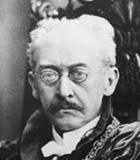
On Aug. 11, 1914 Estonian-born liberal Protestant theologian-historian Prof. Adolf von Harnack (1851-1930) (head of the royal library) gives a speech in Berlin's town hall warning of the threat to Western civilization from "the civilization of the Horde that is gathered and kept together by despots, the Mongolian Muscovite civilization. This civilization could not endure the light of the eighteenth century, still less the light of the nineteenth century, and now in the twentieth century it breaks loose and threatens us. This unorganized Asiatic mass, like the desert with its sands, wants to gather up our fields of grain."

On Mar. 13, 1921 after driving the Chinese out of Urga (Ulaan Baatar) in Feb., Mongolia declares independence from China, and gains it on July 11 (National Day), led by German-Estonian "Bloody White Baron" Roman Nikolai Maximilian von Ungern-Sternberg (1886-1921), who declares himself khan of Mongolia, adopting Mongolian dress and trying to pass himself off as Genghis Khan's successor; too bad, after he establishes a protectorate over the Bogd Khan, a Red Army defeats him next July-Aug., causing him to flee W with his troops hoping to set himself up later as king of Tibet, only to be handed over by his own soldiers to the Red Army on Aug. 21 for his dictatorial abuses, and executed in Novosibirsk on Sept. 21 - viva Genghis Khan?
On Nov. 26, 1924 the Mongolian People's Repub. (ends June 29, 1990) is proclaimed, becoming the 2nd Communist country on Earth after the Soviet Union; the name of the capital city Urga is changed to Ulan Bator (Ulaan Baatar) (Ulaanbaatar) ("red hero").
On Mar. 7, 1925 the Soviet Red Army occupies Outer Mongolia.
In 1929 Comrade Stalin begins forced collectivization of Soviet farms, killing the kulaks off and crippling agriculture; his good friend (opponent) Nikolai Bukharin (1888-1938) is deprived of all his posts by the Soviet govt.; in Mongolia the nomads slaughter millions of head of livestock rather than turn them over.
On Mar. 12, 1936 after a gentleman's agreement in response to Japanese expansionism on Nov. 27, 1934, the Soviet-Mongolian Mutual Assistance Treaty is signed.
On Aug. 13, 1937 the Soviets forge Japanese invasion plans to announce the stationing of troops along the S and SE frontiers of Mongolia to support China in its war with Japan; on Aug. 24 Soviet deputy defense minister Pyotr Smirnov arrives to oversee the transfer of the Soviet 17th Army.
On May 11-Sept. 16, 1939 after Japan claims the Khalka River (Khalkhyn Gol) as the border between Manchuria (Manchukuo) and Mongolia, while the Soviets and Mongolians claim it as the village of Nomonhan 16 mi. to the E, the Battle of Khalkhin Gol (Nomonhan Incident) along the Khalkha River (Khalkhyn Gol) on the Mongolian-Manchurian border sees Soviet troops under Gen. Georgi Zhukov deliver a decisive defeat to the Japanese Sixth Army in Inner Mongolia.
On June 20, `1941 on Stalin's orders the tomb of Mongol conqueror Tamerlane (Timur the Lane) (1336-1405) is opened despite public outcries, and sure enough, an inscription is found inside reading: "Whoever opens my tomb shall unleash an invader even more terrible than myself"; no surprise, 2 days later the Nazis invade the Soviet Union, ultimately killing 30M Soviets; the remains are returned to the tomb on Dec. 20, 1942, after which the Soviets win the Battle of Stalingrad on Feb. 2, 1943.
On Aug. 8, 1945 the Soviet Union declares war on Japan; on Aug. 9 120K of 1M Soviet troops invade Korea and Manchuria; on Aug. 9-20 the Soviet Invasion of Manchuria (Operation August Storm) liberates Manchuria, Inner Mongolia, and N Korea, partitioning the Korean Peninsula, and returning Manchuria and Inner Mongolia to China; on Aug. 10 24 hours after the first Mongolian troops and their Soviet allies cross the border into Japanese-occupied China at the Little Khural (Mongolian Parliament) issues a formal declaration of war against Japan.
In 1989 the Revs. of 1989 (Fall/Autumn of Nations) sees the Soviet Union disintegrate, starting in Poland, then Hungary, East Germany, Bulgaria, Czech., and Romania.
On Jan. 2-Mar. 9, 1990 the 1990 Mongolian Rev. peacefully overthrows the Socialist Mongolian People's Repub. (founded Nov. 26, 1924) in favor of a market economy and multi-party system.On July 22, 1990 voters in Mongolia begin casting ballots in their Communist-ruled nation's first multiparty election.
On Jan. 13, 1992 the 1992 Mongolian Constitution is ratified (effective Feb. 12), establishing a Western-style representative democracy complete with civil rights incl. freedom of religion, speech, press, and movement.
On Jan. 1, 1994 Estonia adopts a flat income tax of 26%, lowering it to 20% in 2009; other former Soviet satellite countries follow suit, incl. Latvia (1995), Lithuania (1995), Russia (2001), Serbia (2003), Ukraine (2004), Slovakia (2004), Georgia (2005), Romania (2005), Kyrgyzstan (2006), Macedonia (2007), Mauritius (2007), and Mongolia (2007).
On Mar. 14, 2018 the statistics bureau in Mongolia reports that the harsh winter dzud killed 709K head of livestock in Jan.-Feb., the most since 2011.